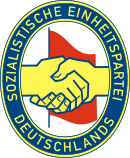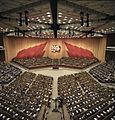Socialist Unity Party of Germany facts for kids
Quick facts for kids
Socialist Unity Party of Germany
Sozialistische Einheitspartei Deutschlands
|
|
|---|---|
| Founded | 1946 |
| Dissolved | 1990 (renamed PDS) |
| Merger of | Communist Party of Germany (KPD), Social Democratic Party of Germany (SPD) |
| Succeeded by | Party of Democratic Socialism (PDS) |
| Newspaper | Neues Deutschland |
| Youth wing | Free German Youth |
| Ideology | Marxism–Leninism |
| International affiliation | Cominform |
| Colors | Red |
The Socialist Unity Party of Germany (in German: Sozialistische Einheitspartei Deutschlands), often called the SED, was the main political party in East Germany. It was in charge from 1949, when East Germany was formed, until the elections in 1990.
The SED was created in April 1946 in Berlin. The Soviet Union made members of the Social Democratic Party of Germany (SPD) and the Communist Party of Germany (KPD) join together. This happened in the parts of Germany and Berlin that the Soviets controlled after World War II.
After 1990, the party changed its name to the Party of Democratic Socialism (PDS). Later, in 2005, it became part of the Left Party.PDS. This party is still somewhat popular in areas that used to be East Germany. It often wins seats in local and state elections.
In 2005, the PDS worked with another group called WASG. This group was started by Oskar Lafontaine, who had left the SPD. The PDS and WASG officially joined together in 2007.
A famous poster from the SED once said: To learn from Stalin means to learn how to win. Later, the word Stalin was changed to the USSR. When Gorbachev became the leader of the USSR, this slogan was stopped. The SED did not agree with his new ideas about perestroika, which meant making changes.
At first, the SED had a branch in West Berlin. But in 1962, this West Berlin branch became a "separate" party. It was called the Socialist Unity Party of West Berlin (Sozialistische Einheitspartei Westberlins – SEW). Even though it was separate, it had the same ideas as the main SED party.
The End of the SED's Power
After the Berlin Wall fell in November 1989, big changes happened. The old Social Democratic Party started up again as its own group. The SED lost many members during this time.
In December 1989, at a special meeting, the SED changed its name. It became the Party of Democratic Socialism (PDS). By changing its name, the party was able to continue existing after East and West Germany reunited. Over time, it even started to grow again. The PDS managed to get representatives elected to the Bundestag, which is the German parliament.
On December 1, 1989, the SED had to give up its power. For 40 years, it had been the only legal party in East Germany. The State Council, which was a government body, removed the rule that made the SED the only party. Three days later, the leader of the SED and all the top officials resigned. The party officially ended on December 16, 1989.
Leaders of the SED Party
(Called "First Secretary" from 1953 to 1976)
- Walter Ulbricht (July 1950 – May 3, 1971)
- Erich Honecker (May 3, 1971 – October 18, 1989)
- Egon Krenz (October 18, 1989 – December 3, 1989)
These three leaders were very powerful in East Germany. They were like the Prime Minister or President in other countries. They led both the government and the main political party. This was not always the case in other Communist countries.
Images for kids
-
21 April 1946: Otto Grotewohl (right) and Wilhelm Pieck (left) shake hands. This shows the joining of the SPD and KPD. Walter Ulbricht is sitting in front, to the right of Grotewohl.Avraham Pisarek
-
The 11th Party Congress held in the Palast der Republik in East Berlin.
See also
 In Spanish: Partido Socialista Unificado de Alemania para niños
In Spanish: Partido Socialista Unificado de Alemania para niños





